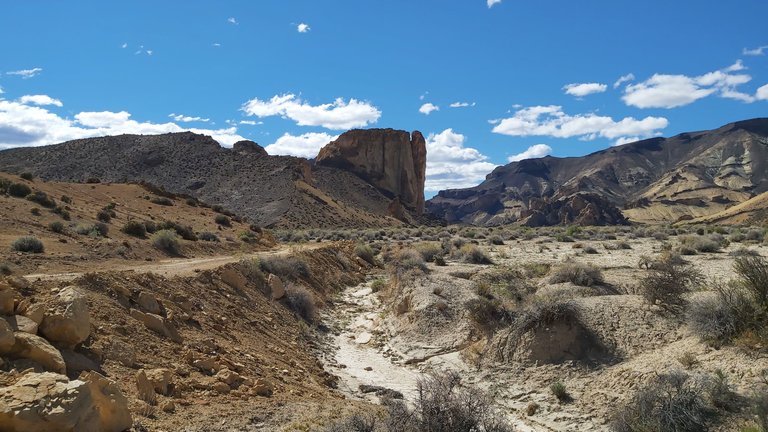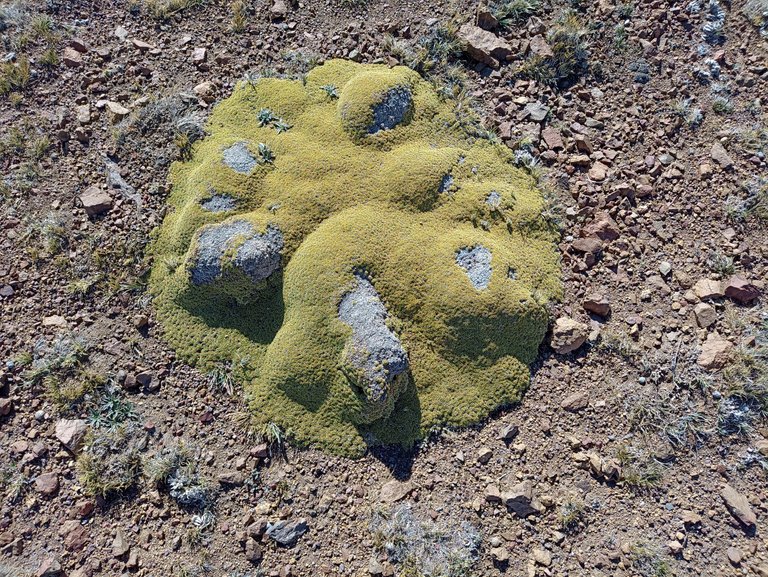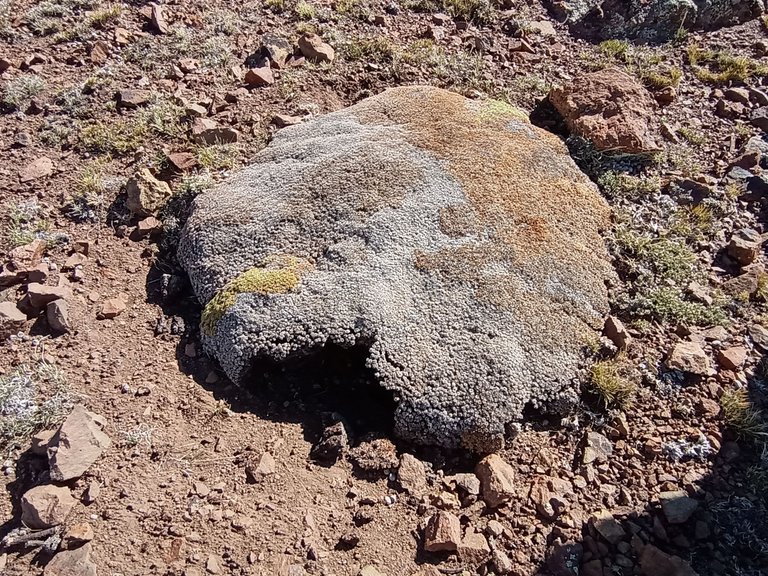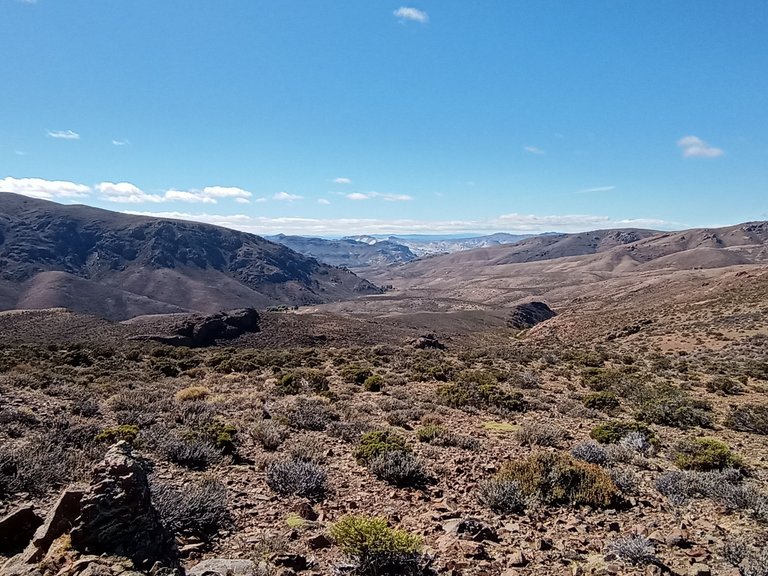
The excursion through La Caldera located northwest of the province of Chubut, 40 kilometers from the town of Gualjaina lasted more than 7 hours, we traveled 160 kilometers, we saw wonderful landscapes and amazing native flora and fauna. I have enough material to write several notes, I have already published some and will continue today and probably some other day.
The plants of the Patagonian plateau are varied, there are probably more species than previously imagined, some of them with strange shapes; perhaps they do not have the color and beauty of those where water abounds, the soil is fertile and the climate is mild, however, merit cannot be taken away from them, they do what they can in an area where environmental conditions are so unfavorable.

All of them are squat and many have spines, some are poisonous, even to the point of being dangerous to human and animal life. Most are used by the few inhabitants of the area and also in some more populated places such as the nearby village of Gualjaina, to cure various conditions.
Among the great diversity of flora, our guide mentioned several such as the bitter coirón, Piche tail or cat's claw, blackthorn, black bush, murtilla whose red fruits are edible (my wife tried them and did not like them), neneo that gives off a strong unpleasant smell, rosehip and mistletoe, the latter are quite similar shrubs although they differ mainly by the leaf and in flowering time by the rosehip flower from which a red fruit emerges, ideal for making an exquisite sweet.

To demonstrate the healing properties of a plant whose name I did not record, Daniel, pressed a yellowish flower from which a whitish liquid similar to milk came out, very sticky, according to his words to adhere to the legs of insects that then carry out pollination. He placed it in a crease of the hand of my wife who had a cast for a fracture of the 5th. metacarpal of her left hand and whose friction with her skin hurt her, in a few hours her small wound had almost completely disappeared and she did not hurt.
One of the plants that caught our attention was the Leña piedra or yareta, a flat shrub no more than 5 centimeters tall with an intense green color that forms a kind of cushion, generally on stones that cover it entirely. Daniel showed us a completely dry one that had lost its greenish color to become gray, almost black. This dry plant is used by the locals to place in their stoves and wood stoves and use them as an excellent fuel, with great caloric power and long-lasting.

It is fascinating to understand how nature provides so many tools for those who live in desolate places and without access to the comforts of large urban centers. Some of us may think that this way of life is not comfortable or safe, probably that opinion is not shared by those who have lived there for many years and continue to provide themselves with what they need to move forward.

La excursión por La Caldera ubicada al noroeste de la provincia de Chubut, a 40 kilómetros del pueblo de Gualjaina duró más de 7 horas, recorrimos 160 kilómetros, vimos paisajes maravillosos y una flora y fauna autóctona sorprendente. Tengo material suficiente como para escribir varias notas, ya algunas he publicado y continuaré hoy y probablemente algún otro día más.
Las plantas de la meseta patagónica son variadas, probablemente haya más especies de las imaginadas previamente, algunas de extrañas formas; quizás no tengan el colorido y la belleza de aquellas donde el agua abunda, el suelo es fértil y el clima benigno, sin embargo, no se les puede quitar méritos, hacen lo que pueden en una zona donde las condiciones del medio ambiente son tan desfavorables.
Todas ellas son achaparradas y muchas tienen espinas, algunas son venenosas, incluso hasta el extremo de ser peligrosas para la vida humana y de los animales. La mayoría son utilizadas por los escasos habitantes de la zona y también en algunos lugares más poblados como la cercana aldea de Gualjaina, para curar diversas afecciones.
Entre la gran diversidad de flora, nuestro guía mencionó varias como el coirón amargo, cola piche o uña de gato, espino negro, mata negra, murtilla cuyos frutos rojos son comestibles (mi esposa los probó y no gustaron), neneo que desprende un fuerte olor desagradable, rosa mosqueta y muérdago, estos últimos son arbustos bastante similares aunque se diferencian principalmente por la hoja y en época de floración por la flor de la rosa mosqueta de donde emerge un fruto rojo ideal para fabricar un exquisito dulce.
Para demostrar las propiedades curativas de una planta cuyo nombre no registré, Daniel presionó una flor amarillenta de donde salió un líquido blanquecino parecido a la leche, muy pegajoso, según sus palabras para adherirse a las patas de los insectos que luego realizan la polinización. Se lo colocó en un pliegue de la mano a mi esposa que tenía un yeso por una fractura del 5to. metacarpiano de la mano izquierda y cuyo roce con la piel la lastimaba, en pocas horas la pequeña herida había desaparecido casi por completo y no le dolía.
Una de las plantas que llamó nuestra atención fue la Leña piedra o yareta, un arbusto chato de no más de 5 centímetros de altura de color verde intenso que forma una especie de cojín, generalmente sobre piedras que cubren en su totalidad. Daniel nos mostró una totalmente seca que había perdido su coloración verdosa para pasar a ser gris, casi negro. Esa planta seca es utilizada por los habitantes del lugar para colocar en sus estufas y cocinas a leña y utilizarlas como un excelente combustible, de gran poder calórico y duradero.
Es fascinante comprender como la naturaleza provee tantas herramientas para aquellos que viven en lugares desolados y sin acceso a las comodidades de los grandes centros urbanos. Algunos podemos pensar que esa forma de vida no es cómoda ni segura, probablemente esa opinión no sea compartida por aquellos que han vivido allí por muchos años y continúan proveyéndose de lo que necesitan para seguir adelante.
Las fotografías son de mi propiedad excepto las que menciono la fuente.
The photographs are my property except those mentioned by the source.
Héctor Gugliermo
@hosgug